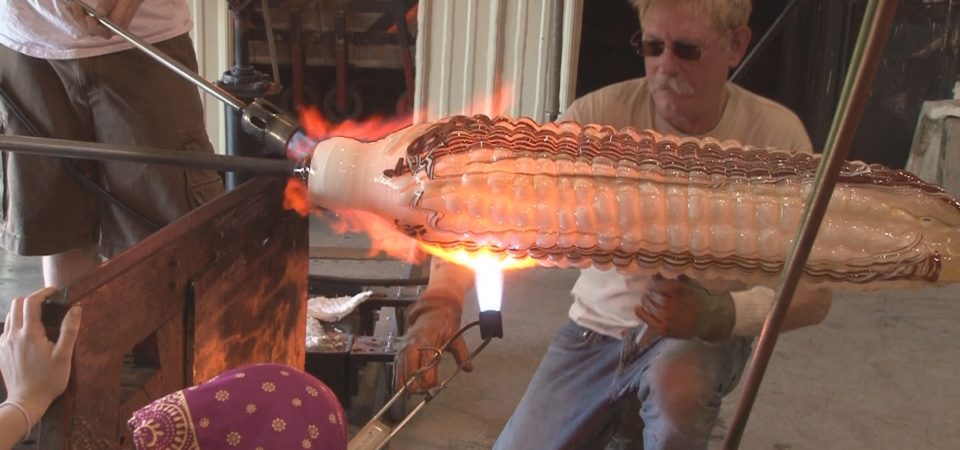“An ear of corn is the point of convergence for my dual careers in farming and art. Corn is not a typical subject in art. But for me, the lines, rows, numbers, higher prices, lower prices, color spectrums, mapping, information technology, air masses, and species have all combined to have unwittingly become a catalyst.” Mick Meilahn
by David J. Wagner, Ph.D.
Copyright Permission: This article may be excerpted as long the author is
credited and the photos are captioned with the artist’s name and artwork title.
Mick Meilahn creates sculpture installations that deal with the implications of genetic engineering for agriculture and the ecology of food, in particular, corn, which was introduced by Native Americans to Europeans over 500 years ago.
Meilahn learned glass-making as a student in Wisconsin in the 1960’s and, along with other glass artists of his generation, subsequently formed a wave that established The American Studio Glass Movement. As a kid, Meilahn grew up on his family’s Midwestern Wisconsin farm and ultimately took the farm over as a third-generation farmer.

PRIMORDIAL SHIFT is a quintessential example of Meilahn’s recent installations. It is about change . . . that is, the broad arc of change from early domestication of corn by indigenous peoples in the area of what is now southern Mexico to genetic engineering induced by science in the 20th Century; namely the paradigm shift which enabled scientists to unravel genetic code of organisms contained in DNA; and the modification and commodification of plants and animals and implications for consumers.
PRIMORDIAL SHIFT consists of 32 hand-blown glass ears of corn averaging 4’ high suspended on stalks of cord with leaves of cast bronze, and a backdrop of video projected to create an illusion of gentle swaying in the breeze. The installation, which measures approximately 30’x30’ hung from a 16′ ceiling, is surrounded by a video of a cornfield on Meilahn’s own family farm projected in the round on gallery walls, nestled in surround-sound audio which includes the chirping of birds and rustling of leaves.
PRIMORDIAL SHIFT is, of course, a work of art. But underlying its aesthetic is an agnostic, if not ambivalent philosophy concerning agronomy, in other words, crop science, and the application of that science by horticulturists to plant production, improvement, marketing, and the enhancement of Earth’s human and animal life:
“With today’s sophisticated technology and global positioning, a 24-row corn planter can plant 500 acres a day with laser accuracy, 35,000 plants per acre with placement exactly 6” apart, and 1¾ “deep. The instant the seed hits the ground, germination begins. That germination is as primal as it gets. Its everywhere! Just look. The shift part is engineered; with results that are all so convenient. Is this shift good? You decide.”, says Mick Meilahn.
In that sense, PRIMORDIAL SHIFT along with most of Meilahn’s other installations (the most overt exception being FIELD OF MINES), are not agents for or of change, but rather, artworks which question the pros and cons of genetic modification.
Mick (Michael) Meilahn (b. 1946) grew up on a family farm near Pickett, in Central Wisconsin. After graduating in 1964 from high school in Ripon where he excelled in art, he entered the University of Wisconsin-River Falls to study agriculture. He subsequently switched his major to art, after he realized agri-business was not his passion. At UW-River Falls he took his first course in glass, and in 1966 he started blowing glass, this at the same time that Harvey Littleton was running the studio glass program at UW-Madison that he made famous by graduating a slew of glass evangelists, the most famous of which would be Dale Chihuly. As an undergraduate, Mick Meilahn spent a Quarter abroad working with glass legend Erwin Eisch in Frauenau, Germany (on the Bavaria/Czech border, an area with a rich tradition of glass making). After graduation in 1971, he spent a year in Bolivia as an idealistic Peace Corps volunteer intent on helping people in South America by sharing the knowledge he’d learned from farming. After that, he enrolled at Illinois State University, Normal, where Joel Philip Myers had begun a glass program, and earned his Master’s degree in art.
Ultimately, though, Meilahn’s roots drew him back to his family’s farm in 1975 where he and his wife, Jane, raised their children and where he alternately operated the family farm and the hot glass studio he built.
In time, Meilahn’s passion for art and farming became one-in-the-same as a form of creative expression. Since 1996, when he turned 50 and began planting genetic seed, Meilahn’s artwork has focused on genetic modification, which has symbiotically shaped his life and work, both as an artist and a farmer. His installations afford viewers the opportunity to view and contemplate the production of corn, from the dual perspective of an artist who knows the subject from life. For the past 15 years or so, this convergence has been the basis for a number of important works.
Meilahn’s choice of corn as an icon is not only relevant to The Midwest where he has roots, but also to the nation and beyond. The nation’s (and the world’s for that matter) reliance on corn production is broad. But The Upper Midwest is particularly immersed in corn production. In the U.S. the top-ranking corn-producing states in descending order of production are 1. Iowa, 2. Illinois, 3. Nebraska, 4. Minnesota, 5. Indiana, 6. South Dakota, 7. Kansas, 8. Wisconsin, 9. Missouri, 10. Ohio. In 2016, the nation’s top twenty states produced over 100 million bushels of corn, 2 billion of which were produced in Iowa and Illinois (source: NASS/USDA). Whereas corn has personal meaning and value for Mick Meilahn, corn is broadly iconic these days in terms of food, agribusiness, and culture.
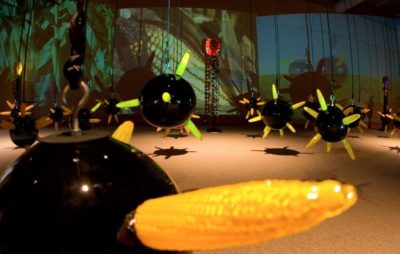
In 2006 Mick Meilahn installed FIELD OF MINES at Ripon College, near his family farm in Wisconsin. Anything but ambivalent, it is a literal visual statement about the potential of genetic modification gone bad. In 2008, The Figge Art Museum in Davenport, Iowa commissioned CORN ZONE, an installation measuring 18’hx40’sx40’, which was so popular that staff now reinstall it annually each Summer, as a tradition, much to the enjoyment of Iowans throughout the region.
In 2012, Meilahn installed the first iteration of PRIMORDIAL SHIFT at the Peninsula School of Art in Door County, Wisconsin. It is scheduled for long-term display beginning in July 2021 at The Riverfront Museum in Peoria, Illinois, home of Caterpillar Inc., formerly Caterpillar Tractor Company (1925–86), a major manufacturer of agricultural equipment and implements. In Peoria, PRIMORDIAL SHIFT will be paired in tandem with Meilahn’s BONANZA BLUE, which was unveiled in 2019 at The James Museum in St. Petersburg, Florida, as one of a number of installations featured in the blockbuster, traveling museum exhibition, ENVIRONMENTAL IMPACT II.
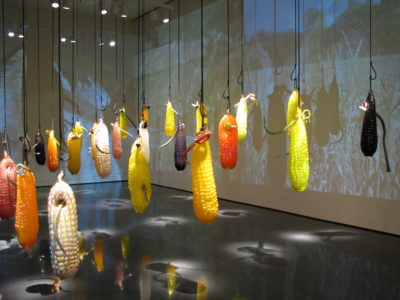
Mick Meilahn: “I recognize and thank the indigenous peoples of the Americas for their contributions to agriculture; particularly, the birth of corn. Some ten thousand years ago in Mexico, two grasses, Teosinte and Zea Mays were cross-pollinated. Since the time when communal survival depended on the development of the terrace method of farming, the corn plant has gone through staggering change and growth. . . . Over eons of time, corn was a symbol as sacred to Native Americans as the cross was to Christianity. . . . [But] in the last 25 years, agriculture and science have advanced exponentially faster than social acceptability. . . . For me, the challenge is whether we can feed a billion more humans on a shrinking planet and at what price.”
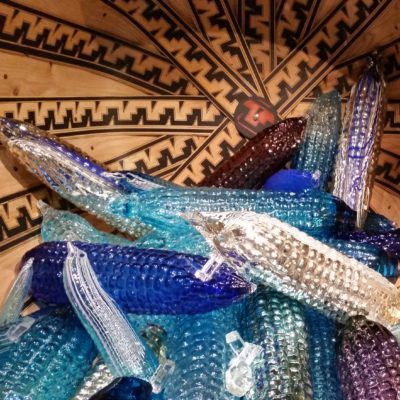
Video about the Production of PRIMORDIAL SHIFT: youtube.com/watch?v=rzAfboceaMo
Video of Mick Meilahn Talking About PRIMORDIAL SHIFT: youtube.com/watch?v=Kmy_7t2vsh0
Michael Meilahn Studios: michael-meilahn.com/
Information about ENVIRONMENTAL IMPACT II which includes BONANZA BLUE: davidjwagnerllc.com/Environmental_Impact-Sequel.html
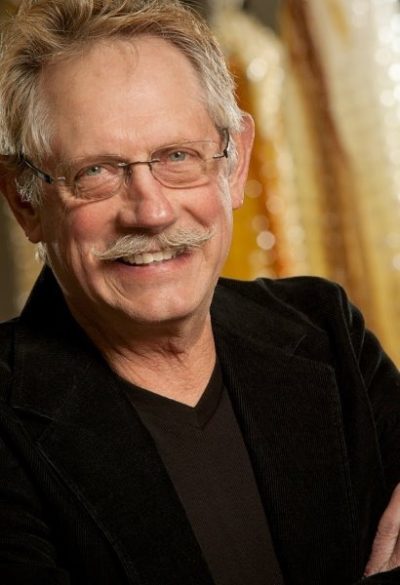 Mick Meilahn currently serves as the President of The Board of Directors of the Bergstrom-Mahler Museum of Glass in Neenah, Wisconsin. He has taught at Penland School of Craft in North Carolina and The Archie Bray Foundation in Montana. His work has been exhibited in the traveling museum exhibitions, Wisconsin’s Glass Masters and Environmental Impact, produced by David J. Wagner, L.L.C., the annual Smithsonian Craft Show, and at The Corning Museum of Glass, which has also featured in over four decades in its New Glass Review.
Mick Meilahn currently serves as the President of The Board of Directors of the Bergstrom-Mahler Museum of Glass in Neenah, Wisconsin. He has taught at Penland School of Craft in North Carolina and The Archie Bray Foundation in Montana. His work has been exhibited in the traveling museum exhibitions, Wisconsin’s Glass Masters and Environmental Impact, produced by David J. Wagner, L.L.C., the annual Smithsonian Craft Show, and at The Corning Museum of Glass, which has also featured in over four decades in its New Glass Review.
The PRIMORIAL SHIFT museum exhibition tour is produced by David J. Wagner, L.L.C., David J. Wagner, Ph.D. Curator/Tour Director. Website: https://www.davidjwagnerllc.com/exhibitions.html#PS
This blog is part of MAHB’s ENVIRONMENTAL IMPACT II series, a travelling museum’s exhibition.
The MAHB Blog is a venture of the Millennium Alliance for Humanity and the Biosphere. Questions should be directed to joan@mahbonline.org
The views and opinions expressed through the MAHB Website are those of the contributing authors and do not necessarily reflect an official position of the MAHB. The MAHB aims to share a range of perspectives and welcomes the discussions that they prompt.
